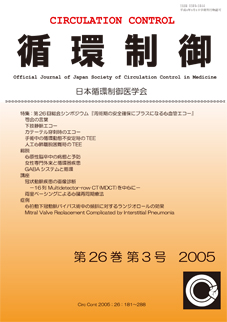All issues

Volume 26 (2005)
- Issue 4 Pages 314-
- Issue 3 Pages 247-
- Issue 2 Pages 140-
- Issue 1 Pages 24-
Volume 26, Issue 3
Displaying 1-2 of 2 articles from this issue
- |<
- <
- 1
- >
- >|
case reports
-
Kazuo Abe, Junko Oka, Shigeru Miyagawa, Mugiho Takeuchi, Masao Yoshita ...2005Volume 26Issue 3 Pages 247-250
Published: 2005
Released on J-STAGE: July 07, 2006
JOURNAL FREE ACCESSThe administration of an ultra-short acting β1 blocker has been introduced as a novel method for the treatment of supraventricular tachycardia during cardiac surgery. In the present study, the effect of ultra-short acting β1 blocker, landiolol, on tachycardia during off-pump coronary artery bypass graft was investigated. Landiolol 0.125mg/kg was injected intravenously and landiolol 0.04mg/kg/min was infused continuously for 30 minutes in twenty patients who were scheduled for off-pump CABG and demonstrated supraventricular tachycardia (100bpm<) during the preparation of intra thoracic artery. At 10min after the start of ladiolol infusion, the heart rate was significantly decreased from 112±8 to 98±10bpm and the mean artery blood pressure was significantly decreased from 74±16 to 67±13mmHg. Other hemodynamic parameters did not significantly change during ladiolol infusion. These results may suggest the efficacy of ladiolol for reducing tachycardia during off-pump CABG.View full abstractDownload PDF (56K) -
Ryu Okutani, Masaaki Iwaya2005Volume 26Issue 3 Pages 251-254
Published: 2005
Released on J-STAGE: July 07, 2006
JOURNAL FREE ACCESSA 59-year-old male underwent mitral valve annuloplasty for mitral valve prolapse. The postoperative course was uneventful. However, three months after operation, he developed general malaise and dyspnea, and was readmitted to hospital. Echocardiography revealed mitral valve regurgitation(IV°), and chest x-ray showed an infiltrative shadow in the right lung. A diagnosis of interstitial pneumonia was confirmed based on an increase in serum KL-6 to 1,400 U/ml, and lung biopsy. Respiratory functions improved after about one month of mechanical ventilation and steroid pulse therapy, but 3 l/min of oxygen by nasal cannulae was still required. Chest x-ray revealed that the pneumonia had stabilized, although the serum KL-6 value remained high. Then, mitral valve replacement was performed. Extubation was done two days after surgery, and his respiration was stable thereafter. The serum KL-6 level decreased from 1,170 U/ml on the day of surgery to 541 U/ml 10 days after surgery.View full abstractDownload PDF (68K)
- |<
- <
- 1
- >
- >|